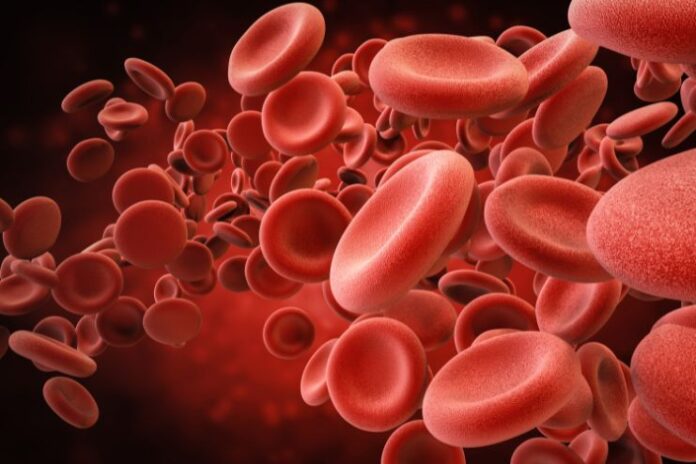Affiliate Disclaimer
Some links in this article are affiliate links. We may earn a small commission if you make a purchase through these links, at no extra cost to you. We only recommend products we find useful to our readersWhat happens when you get a small cut or injury? You might not think about it, but your body has a remarkable defense system in place to stop the bleeding. Platelets—tiny but mighty blood cells—rush to the injury site to form clots and seal the wound. It’s almost like your body’s own natural band-aid, helping you heal. Produced in the bone marrow, platelets play a key role in your overall health and well-being.
But what if your platelet count drops? This condition, called thrombocytopenia, can lead to bruising, excessive bleeding, and other health concerns. Factors like viral infections, autoimmune diseases, and certain medications can contribute to low platelet counts. The good news is that you can naturally raise your platelet levels by incorporating specific foods into your diet.
In this article, we’ll explore the causes and symptoms of low platelet count, and share foods that can help boost your platelet levels. Plus, we’ve got some simple, delicious recipes that make boosting your platelets easy and enjoyable.
Causes Of Low Platelet Count
Platelets play a critical role in clotting and preventing excessive bleeding. When your platelet count becomes too low—a condition known as thrombocytopenia—it can lead to symptoms like fatigue, easy bruising, and prolonged bleeding from small wounds. In more severe cases, it can cause internal bleeding or life-threatening hemorrhages. For women, low platelets can also result in irregular or heavy menstrual bleeding.
Thrombocytopenia can be caused by a variety of underlying conditions, including:
Common Causes of Low Platelet Count:
- Infections & Diseases: Viral infections such as Hepatitis, HIV, and Dengue, as well as autoimmune disorders like ITP (Immune Thrombocytopenic Purpura) and Lupus, can lead to a decrease in platelet count.
- Nutritional Deficiencies: Deficiencies in key nutrients like iron, vitamin B12, or folate can contribute to low platelet levels in the body.
- Medications & Treatments: Certain medications, including antibiotics, chemotherapy, and radiation therapy, can affect platelet production.
- Lifestyle & Toxins: Excessive alcohol consumption, exposure to pesticides, or contact with heavy metals can also lower platelet counts.
Read More: New Materials Could Drive Wound Healing By Natural Means, New Study Suggests
Symptoms of Low Platelet Count (Thrombocytopenia)
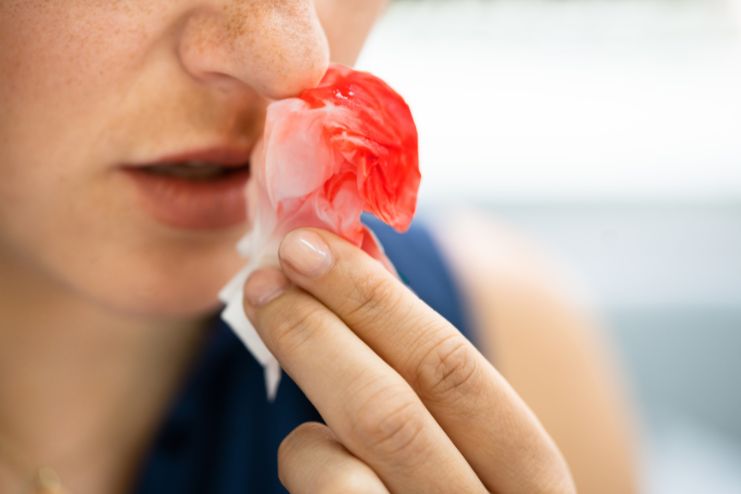
A low platelet count, or thrombocytopenia, can lead to excessive bleeding, easy bruising, and other noticeable symptoms. Since platelets play a vital role in blood clotting, a deficiency can make even minor injuries more complicated. Here are some common signs of low platelet count:
- Frequent Bruising: You may notice bruises appearing easily, even from minor bumps, due to decreased clotting ability.
- Prolonged Bleeding: Cuts, scrapes, or wounds may take longer to stop bleeding than usual.
- Frequent or Heavy Nosebleeds: Regular or severe nosebleeds can indicate poor blood clotting.
- Bleeding Gums: Your gums may bleed easily, especially when brushing or flossing, due to fragile blood vessels.
- Heavy Menstrual Bleeding: Women may experience unusually heavy or prolonged menstrual periods.
- Blood in Urine or Stools: Urine may appear pink or red, and stools may turn tarry, indicating possible internal bleeding.
- Blood in Vomit: You may notice blood in your vomit, which can be a sign of internal bleeding.
- Petechiae: Tiny red or purple spots, known as petechiae, may appear on the skin, especially on the lower legs, due to leakage in small blood vessels.
- Fatigue: A general sense of tiredness or weakness may affect your daily activities.
If you suspect you have symptoms of a low platelet count, it’s crucial to consult a medical professional. They can perform tests, such as a complete blood count (CBC), to confirm the diagnosis and identify the underlying cause. Once the cause is determined, appropriate treatment can help manage conditions like infections, bone marrow disorders, or autoimmune diseases that may be contributing to low platelet levels.
Essential Nutrients for Platelet Production

The good news is that you can help increase your platelet count through dietary changes. Certain nutrients are crucial for maintaining healthy platelet production. Key vitamins and minerals—such as iron, folate, vitamin K, vitamin B12, and omega-3 fatty acids—play a vital role in platelet function and production.
- Vitamin B12 & Folate: These nutrients support red blood cell production and help prevent anemia, which is often linked to low platelet levels.
- Vitamin K: Essential for effective blood clotting, vitamin K ensures that your body can stop bleeding when necessary.
- Iron: Iron is vital for hemoglobin production, helping keep your blood healthy and supporting overall platelet function.
- Vitamin C: Vitamin C promotes platelet count by supporting production, reducing oxidative stress, and enhancing immune function. It strengthens blood vessels, prevents platelet depletion, and improves iron absorption, which is essential for blood cell formation.
By focusing on a diet rich in these nutrients, you can support your platelet count and promote overall health.
Read More: 6 Best Vitamins To Improve Your Brain Health
Foods To Boost Platelet Count
If you’re dealing with low platelet levels, don’t worry—there are natural ways to improve your platelet count through diet. By including a variety of nutrient-rich foods, you can support your body’s platelet production and regain your overall well-being. A diet full of fruits, vegetables, and whole grains provides the essential nutrients needed for optimal platelet function.
A nutrient-dense diet not only helps boost platelet count but also aids in wound healing, strengthens your immune system, and supports overall health. Let’s take a look at how some everyday foods can help increase your platelet production!
Papaya Leaf Extract:
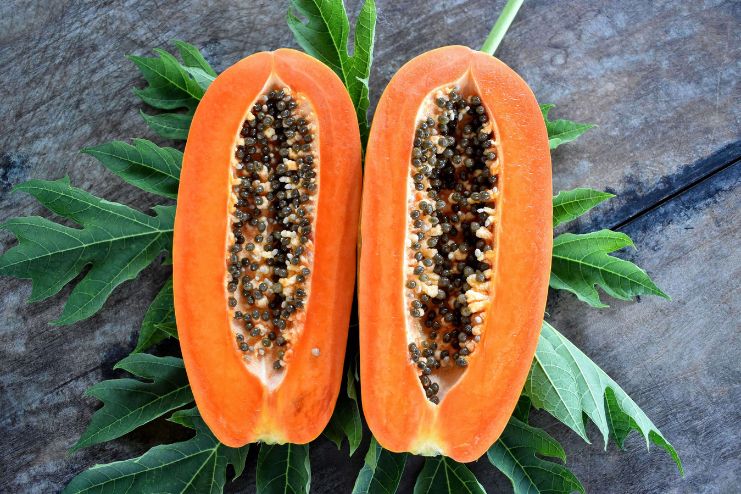
Papaya leaf extract has been traditionally used to support blood health, and recent studies suggest it may help increase platelet levels, particularly in conditions like dengue fever. Research indicates that papaya leaf extract may enhance platelet production by stimulating bone marrow activity, though further studies are needed for conclusive evidence.
The extract can be consumed in various forms, such as teas, juices, or supplements. The dosage, purity, and safety can vary, so it should be used after consulting a healthcare professional.
Papaya Leaf Juice Recipe:
- Wash and chop fresh papaya leaves.
- Blend with water until smooth.
- Strain to remove pulp.
- Add honey or jaggery for taste (optional).
- Drink 30–100ml three times a day before meals.
If you can’t find fresh papaya leaves, you can buy papaya leaf extract. Check out one of our favorite picks here
If you are a tea lover, try experimenting with papaya tea. Check out our favorite papaya tea bags here.
Read More: 10 Incredible Health Benefits Of Papaya Leaf Extract
Pumpkin:
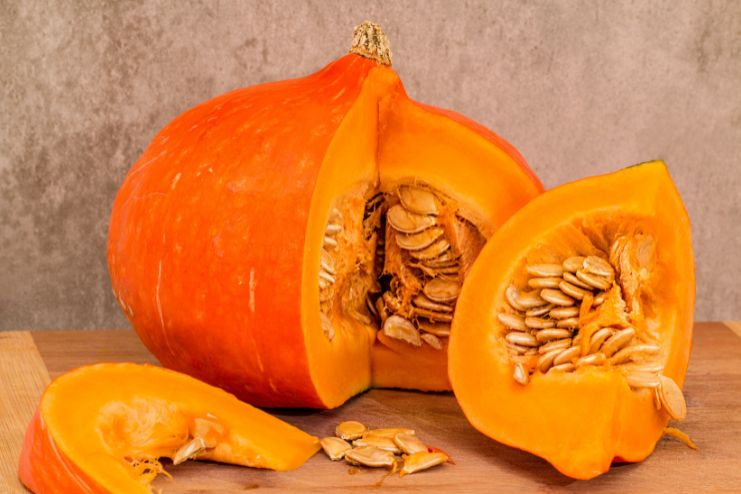
Pumpkin is rich in vitamin A, which plays a key role in promoting platelet production in the bone marrow. It also contains iron and antioxidants, which boost immunity and support overall blood health. A deficiency in vitamin A can disrupt platelet production, while low iron levels (anemia) can lead to a decrease in platelet count. Adding pumpkin to your diet can help increase your platelet levels and improve your overall health.
Here is a delicious way to add pumpkin to your diet:
Creamy Pumpkin Soup:
- Simmer 1 cup pumpkin puree, 1 cup vegetable broth, ½ cup milk (dairy or non-dairy), and ¼ tsp ground ginger in a saucepan over medium heat.
- Stir occasionally and cook for 5-7 minutes until heated through.
- Blend for a smoother consistency if preferred.
- Season with pepper and salt to taste.
- Serve warm and enjoy!
Green Leafy Vegetables:

Leafy green vegetables such as kale, spinach, and fenugreek leaves are rich in vitamin K, folate, and iron, all of which contribute to healthy platelet formation.
Vitamin K plays a crucial role in blood clotting, while folate supports red blood cell formation and helps prevent platelet-related deficiencies. Including a variety of green leafy vegetables in your diet can naturally help maintain platelet count and promote overall blood health.
Here is a quick leafy greens recipe you’ll love.
Simple Sautéed Leafy Greens
- Place a pan over medium heat and pour in a small quantity of oil or water.
- Put in chopped dark leafy greens such as spinach, kale, or collard greens.
- Sauté for 2-3 minutes, stirring occasionally.
- Sprinkle with a pinch of salt and a splash of lemon juice or vinegar for flavor.
- Cook for an additional 1-2 minutes until greens are tender but still bright.
- Serve hot as a side dish or include in soups, salads, or grain bowls.
Pomegranates:
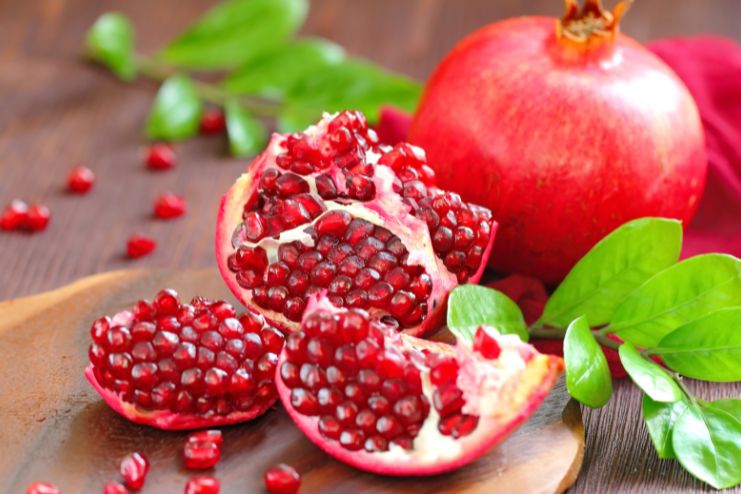
Pomegranates are tasty, juicy, and full of health benefits. They contain high levels of antioxidants, vitamin C, and iron, all of which promote blood circulation and platelet production.
The high antioxidant value protects the platelets from oxidative stress, whereas vitamin C helps with iron and produces red blood cells. Adding to its benefits, pomegranate’s anti-inflammatory properties also support healthy platelet production.
And, like us, if you hate peeling pomegranate seeds, we have a quick, easy, and lazy recipe—just read on!
Here’s an easy juice recipe that will help you increase platelet count:
Fresh Pomegranate Juice:
- Cut a pomegranate in half and tap the back with a spoon to take the seeds out.
- Blend the seeds until smooth.
- Strain the juice using a fine-mesh sieve or cheesecloth to remove pulp.
- Pour into a glass and enjoy fresh juice or chill before serving.
Kiwi:

Kiwi is a good source of vitamins C and K, and antioxidants that increase platelet production and prevent cell damage.
Vitamin C promotes iron absorption, and aids in the production of red blood cells. Vitamin K is essential for blood clotting. The antioxidant content in kiwi is high as well, helping to decrease oxidative stress, which can increase the health of blood generally and keep platelet levels stable.
It is recommended to eat 2-3 kiwis a day to increase platelet production. We have an amazing recipe to make the otherwise sour and bland kiwi tasty.
Take a look at this recipe with kiwi:
Kiwi Cucumber Salad:
- Slice two ripe kiwis and one small cucumber into bite-sized chunks, then put them into a bowl.
- Add ½ cup pomegranate seeds and ¼ cup crumbled feta cheese (optional) for a texture mix.
- Sprinkle 1 tbsp chopped fresh mint leaves for freshness.
- Drizzle 1 tbsp olive oil and 1 tsp lemon juice for a light vinaigrette.
- Season with ¼ tsp black pepper and ¼ tsp salt, then gently toss everything together.
- Serve fresh and enjoy this healthy, nutrient-rich salad!
Wheatgrass:
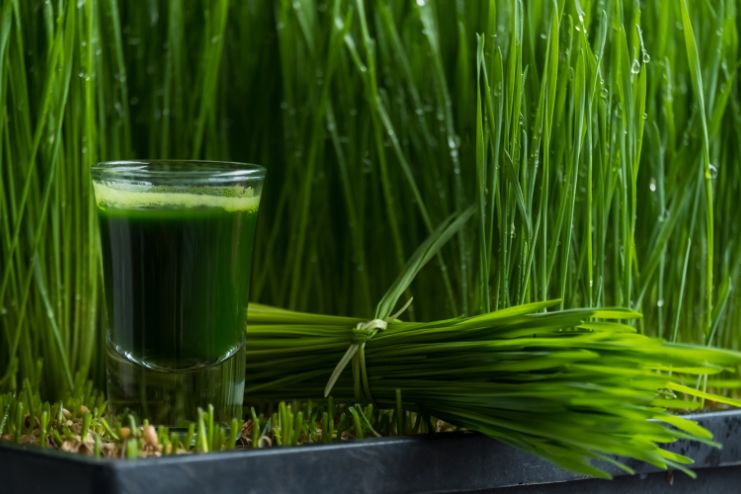
Wheatgrass is known to help boost platelet count due to its high chlorophyll content, which closely resembles the structure of hemoglobin. This similarity may support the production of blood cells, including platelets.
In addition to chlorophyll, wheatgrass is packed with essential nutrients such as vitamins A, C, and K, along with iron and amino acids, all of which contribute to healthy blood formation. Some studies suggest that wheatgrass may be particularly beneficial for people undergoing chemotherapy or those with blood disorders, as it may help increase both red blood cells and platelets.
Tip to Include Wheatgrass in Your Diet:
You can enjoy wheatgrass in juice form or sprinkle its powder over salads, soups, or meals. If you’re drinking wheatgrass juice, start with 1 ounce (30 ml) per day and gradually increase to 2 ounces (60 ml) over a few weeks. For the powder, 2-3 grams twice daily is a typical recommendation.
If you’d rather skip the prep work, you can try this convenient wheatgrass powder!
Carrots:
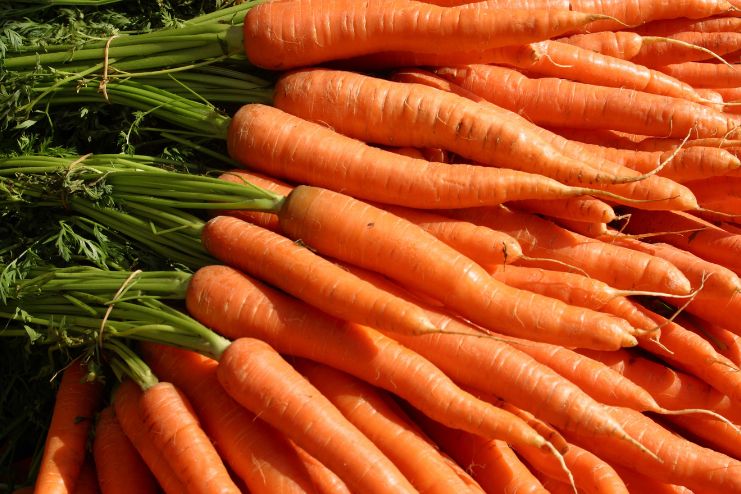
Packed with beta-carotene, vitamin A, and powerful antioxidants, carrots support platelet production and overall blood health by promoting cell reproduction.
Vitamin A is vital in platelet formation and protein synthesis, while antioxidants help protect blood cells from damage. The high beta-carotene content in carrots, which the body converts into vitamin A, promotes cell growth and renewal, increasing the platelet count.
Additionally, carrots provide fiber for better digestion and antioxidants that strengthen the immune system, making them an essential vegetable in your platelet-boosting diet.
Here’s a 5-minute easy one-pot carrot recipe that you can try:
Crunchy Buttery Carrots:
- Slice 1 pound of carrots into rounds.
- Melt ¼ cup of butter in a pan over medium heat.
- Add the carrots and cook for about 5 minutes, stirring occasionally.
- Stir in ¼ cup of brown sugar and a pinch of salt.
- Cover and let simmer for 5-10 minutes until tender and glazed.
- Serve these buttery-cooked carrots warm.
Berries:
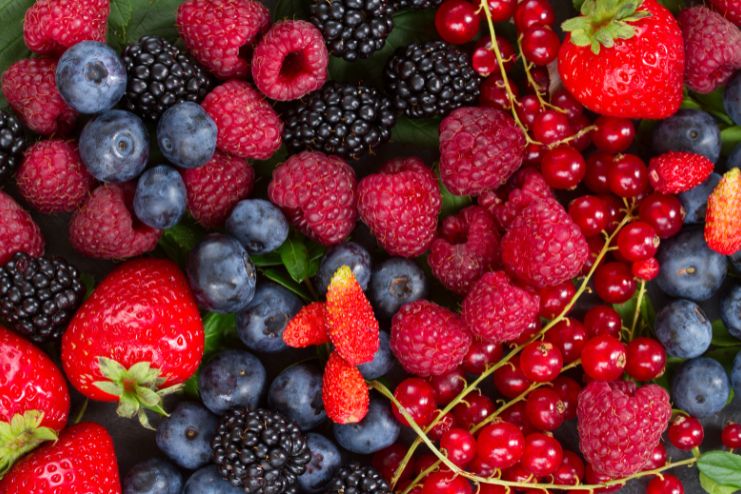
Many of us love berries, adding flavor and nutrition to smoothies, desserts, and jams. But did you know that they can also help boost your platelet count? It’s true! Studies show that berries, packed with antioxidants and polyphenols like anthocyanins, can support platelet function and production.
Berries such as blueberries and strawberries are particularly rich in antioxidants and polyphenols. These compounds help reduce inflammation and oxidative stress, promote healthy platelet function, and support heart health.
Here’s one of my ‘berry’ favorite recipes:
Berries Fruit Salad:
- In a big bowl, mix 2 cups of strawberries (hulled and sliced), 1 cup of blueberries, and 1 cup of raspberries.
- In a small bowl, mix ¼ cup of honey, 2 tablespoons of fresh lime juice, and 1 teaspoon of lime zest with a whisk.
- Drizzle the honey-lime sauce over the berries and toss lightly to coat.
- Let the salad rest for 10-15 minutes to let flavors integrate.
- Serve fresh, and enjoy!
Note that blueberries are rich in natural salicylates, which have weak blood-thinning properties like aspirin, so consume them in moderation.
Read More: Gut-Friendly Overnight Oats with Berries: A Probiotic Breakfast
Dairy Products:

Many of us include at least one or two dairy products in our daily diets, and for good reason—unless you’re allergic to dairy or follow a vegan diet. Dairy products like milk, yogurt, and cheese are rich in nutrients that can help boost platelet levels. They provide calcium, which is essential for blood clotting and proper platelet function, along with vitamin D, which supports the health of your bone marrow—the site where platelets are produced.
Additionally, the protein in dairy aids in cell regeneration, including platelet development, while B vitamins such as B12 and folate play a key role in red blood cell and platelet production. Incorporating dairy into your diet—whether through drinking milk, enjoying Greek yogurt, or adding cheese to meals—can help maintain healthy platelet levels.
Here’s a delicious recipe that has dairy, and boosts platelet count:
Greek Yogurt Egg Pancake:
- In a bowl, whisk together one cup of Greek yogurt and two large eggs until smooth.
- Add ½ teaspoon of vanilla extract and combine well.
- In another bowl, mix ½ cup of all-purpose flour, 1 teaspoon of baking soda, and a pinch of salt.
- Fold the dry ingredients into the yogurt mixture gradually until just combined.
- Heat a skillet on medium heat and grease it lightly with butter or oil.
- Pour ¼ cup of batter for each pancake onto the skillet and cook until bubbles appear on the surface, about 2 minutes.
- Flip and cook for an additional 1–2 minutes until golden brown.
- Serve warm with honey, fresh berries, or maple syrup.
Oranges:
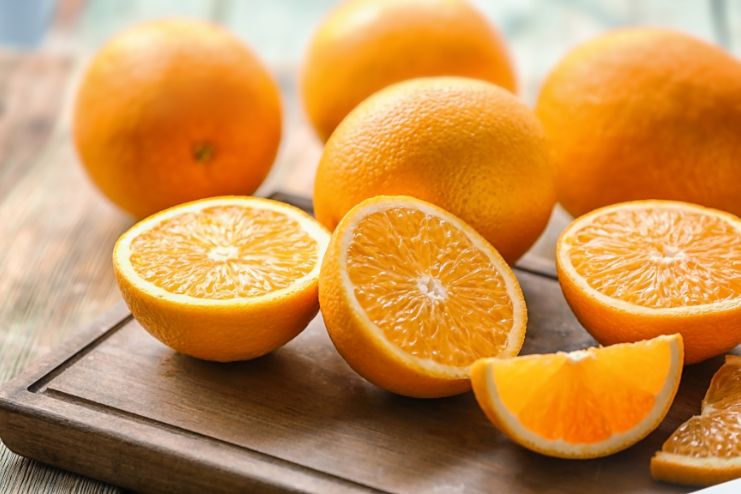
Oranges are a great way to boost platelet count, thanks to their high vitamin C content, which is essential for platelet production. Vitamin C not only enhances iron absorption—a crucial factor in increasing platelet levels—but also acts as a powerful antioxidant, reducing oxidative stress that can damage platelets. As one of the richest sources of vitamin C, oranges play a key role in supporting platelet production.
In addition to vitamin C, oranges also contain flavonoids and folate, which promote overall blood health and improve platelet function. Including oranges in your diet regularly can help strengthen your immune system and support optimal blood circulation, both of which are vital for maintaining healthy platelet levels.
Try this tangy orange recipe that comes together under 5 minutes:
Peppery Orange Delight:
- Peel and cut the orange into cubes.
- Sprinkle a pinch of pepper to add to the taste.
- Enjoy chilled.
Brussels Sprouts:
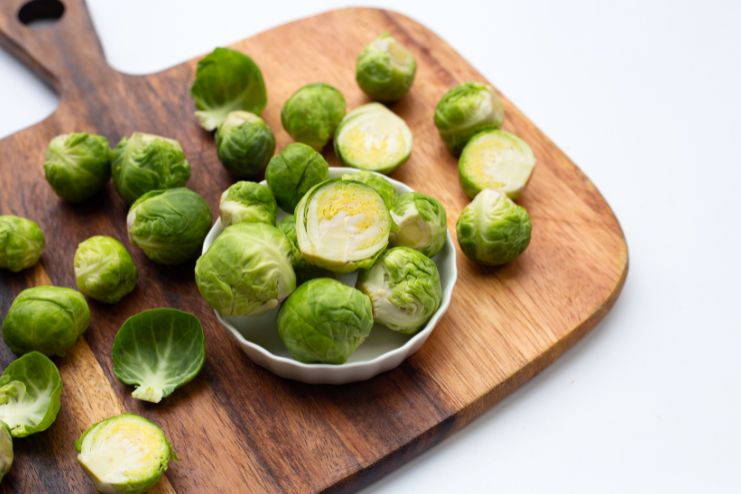
Brussels sprouts are an excellent choice for boosting platelet count. Packed with vitamin K and folate, they support healthy blood clotting and the production and maintenance of blood cells. In addition, Brussels sprouts are rich in vitamin C, fiber, and antioxidants, all of which contribute to overall health.
You can easily incorporate Brussels sprouts into your diet by roasting them, adding them to salads, or stir-frying for a nutritious boost. Read on to know how we like to make our Brussels sprouts.
Try this quick and easy Brussels sprouts recipe:
Sauteed Brussels Sprouts:
- Heat a teaspoon of butter in a skillet over high heat until the butter melts and begins to brown (1–2 minutes).
- Add 1 cup of Brussels sprouts and a splash of lemon juice, stirring constantly until they are heated through and slightly softened (about 45 seconds).
- Season with salt and pepper and serve immediately.
Vitamin B12 Rich Foods:

Vitamin B12 plays a crucial role in platelet production and helps prevent anemia, a common cause of thrombocytopenia. It is also essential for DNA synthesis, supporting normal cell growth, division, and platelet development. A deficiency in vitamin B12 can lead to low platelet levels and impaired blood coagulation.
To maintain healthy platelet counts and overall blood health, incorporate B12-rich foods into your diet, such as beef, liver, salmon, tuna, trout, clams, fortified cereals, and nutritional yeast.
Here’s a quick five-ingredient salmon recipe:
Baked Salmon:
- Preheat oven to 375°F (190°C) and grease a baking dish lightly.
- Place a 3-ounce salmon fillet into the dish and coat it with one tablespoon of melted butter.
- Season with ½ teaspoon garlic powder, ½ teaspoon dried basil, salt, and pepper to taste.
- Bake for 15 to 20 minutes or until flaking easily with a fork.
- Serve warm with your desired sides.
Read More: Vitamin B12 Benefits And Side Effects
Whole Grains:
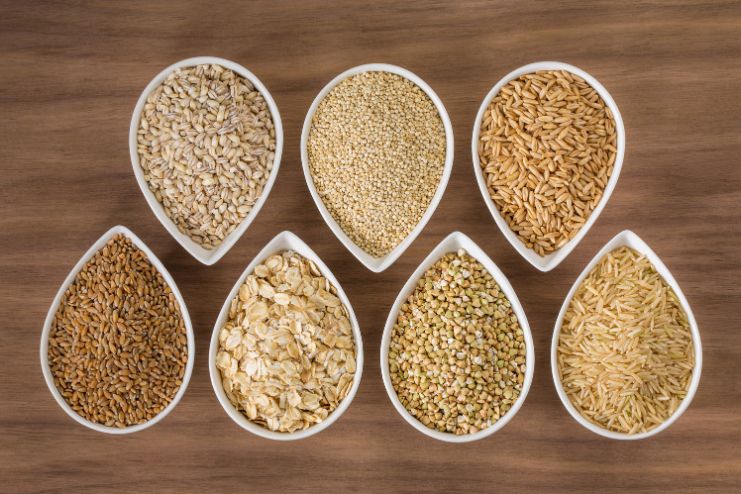
Whole grains play a key role in promoting platelet function by providing essential nutrients like iron, zinc, and B vitamins, which are crucial for platelet production. They are also rich in fiber, which helps regulate blood sugar and cholesterol levels, ultimately preventing clotting disorders.
In addition, whole grains contain antioxidants and polyphenols that support healthy blood vessels, reducing inflammation and oxidative stress. They also promote gastrointestinal health, improving nutrient absorption—such as vitamin K, which is vital for blood clotting.
Here’s our go-to whole-grain recipe:
Overnight Oats with Berries:
- Soak rolled oats with milk of your choice in a lidded jar.
- Refrigerate the mixture overnight.
- Next morning, add chia seeds, nuts, and berries to add to the taste.
Read More: 15 Oats Benefits (Health, Skin and Hair) – The Healthiest Grains On Earth!
Foods and Beverages That May Reduce Platelet Count and Affect Clotting
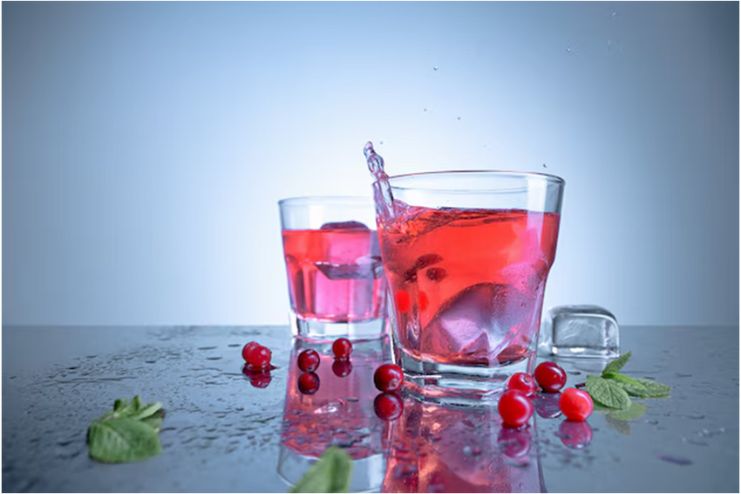
Now that we are aware of foods that promote platelets, it becomes essential to know what foods must be avoided. Certain foods may reduce platelet production or damage them by affecting blood clotting. Here’s a list of foods you must avoid to maintain a healthy number of platelets in the body:
1. Alcohol:
Excessive alcohol intake can inhibit bone marrow function, resulting in decreased platelet production. Alcohol also reduces platelet count, making it difficult for blood to clot normally. Chronic alcohol consumption may enhance platelet destruction within the spleen and liver, resulting in thrombocytopenia.
2. Quinine (Used in Tonic Water and Certain Medications):
Quinine may lead to immune-mediated thrombocytopenia, where the immune system mistakenly targets platelets for attack upon exposure to quinine, resulting in their destruction.
3. Cranberry Juice:
Cranberry juice contains natural substances that may interfere with blood clotting, especially by affecting the action of blood thinners such as warfarin. Excessive cranberry consumption can inhibit platelet production, potentially extending bleeding time.
4. Certain Fruits and Vegetables:
- Red grapes and blueberries are rich in natural salicylates, which have weak blood-thinning properties like aspirin.
- Garlic and onions are rich in sulfur compounds that can prevent platelet clumping and lower blood clotting capacity.
- Ginger is anti-inflammatory and can disrupt clotting by lowering platelet stickiness.
5. Artificial Sweeteners (Aspartame and Others):
Aspartame and other artificial sweeteners have been associated with immune system disturbances, which can damage platelets. They can also play a role in inflammatory reactions, indirectly influencing platelet function.
If you are looking for ways to promote platelet production in the body, try to avoid the above foods.
Additional Tips To Increase Platelets:
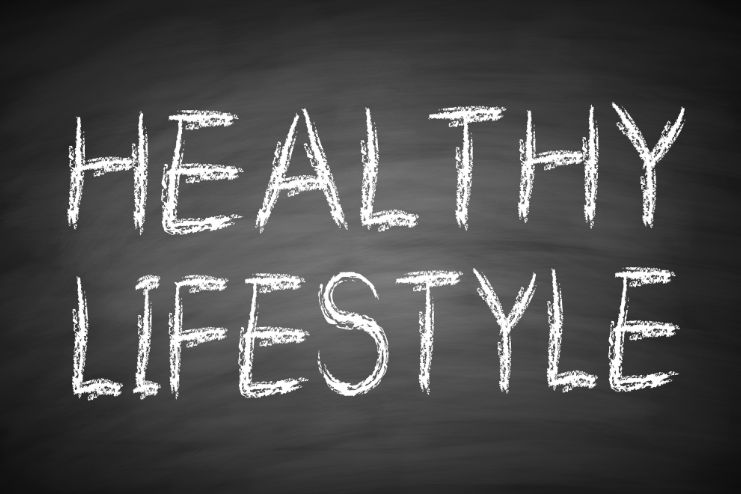
Besides the dietary changes, a few adjustments in your daily routine can significantly boost platelet production. Here are a few tips to increase platelets in the body:
- Hydrate: Consume at least eight glasses of water daily to support blood flow and platelet production.
- Avoid Alcohol: Alcohol has the potential to influence platelet production in the bone marrow and can lead to low platelet counts.
- Check Medicines: Certain medicines, like ibuprofen and aspirin, can affect platelet function. Talk to your doctor about changing your medicines.
- Exercise Daily: Mild activities like walking, swimming, or performing yoga promote blood circulation and keep platelet count in check.
If yoga is your go-to exercise, check out one of the best yoga mats here!
A healthy lifestyle paired with the right diet can help you maintain optimum platelet levels in the body.
Read More: Are You Chronically Dehydrated? Hidden Signs You Need More Water
Final Thoughts:

Platelets are your body’s natural defense against uncontrolled bleeding, and maintaining an optimal platelet count is essential for overall health. A low platelet count, caused by illness, medication, or lifestyle factors, can lead to various health issues. The good news is that natural solutions especially through diet, can help boost platelet production. Including nutrient-rich foods like papaya, leafy greens, pumpkin, berries, and other sources of vitamin B12 can support healthy blood function and clotting.
In addition to diet, simple lifestyle changes, such as staying hydrated, limiting alcohol intake, and engaging in light exercise, can help further improve platelet count. If you suspect a low platelet count, it’s important to consult a healthcare provider for an accurate diagnosis and appropriate treatment.
Ready to take charge of your health the natural way? Start by incorporating some of these superfoods into your daily routine and see the benefits for yourself! Have you tried any of these remedies before? Share your experience in the comments below!
-
Dec 2018Written by Somapika D
-
Sep 2024Edited by Ankita
-
Mar 2025Edited by Vaishnavi
References
- https://pmc.ncbi.nlm.nih.gov/articles/PMC8882865/
- https://www.metropolisindia.com/blog/preventive-healthcare/increase-platelet-count-naturally-foods-tips
- https://pdsa.org/diet-lifestyle
- https://pubmed.ncbi.nlm.nih.gov/18258621/
- https://pmc.ncbi.nlm.nih.gov/articles/PMC6267416/
- https://www.nhlbi.nih.gov/health/thrombocytopenia
- https://pdsa.org/diet-lifestyle
In this Article














